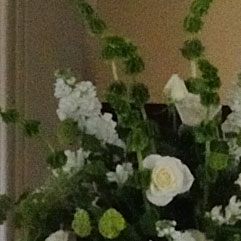Canon EOS 7D
-
-
Written by Gordon Laing
Canon EOS 7D vs Canon EOS 50D vs Canon EOS 5D Mark II High ISO Noise (RAW files matched)
Canon EOS 7D vs Canon EOS 50D vs Nikon D300s High ISO Noise (RAW files matched)
Noise Reduction was set to the default options on each camera, although we disabled any automatic contrast-enhancing modes as these can artificially introduce noise. As such, Auto Lighting Optimizer on both Canon bodies and Active D-Lighting on the Nikon were disabled. The image above was taken with the Canon EOS 7D at 100 ISO with an exposure of 1.3 seconds and with the lens set to 24mm f8; the original RAW file measured 22.5MB. The crops below are taken from the area marked with a red square and presented here at 100%. In this set of crops, we’ve repeated those from the Canon EOS 50D and EOS 7D, and added the Nikon D300s. As a 12 Megapixel camera, the Nikon is the lowest resolution model of the group tested here, hence the larger area in its crops. We processed the D300s RAW file using Nikon’s Capture 2 NX, using its default settings as these matched those from the Canons here. This time the D300s measured the same White Balance as the Canons, so no further adjustments were required. Compared against the previous page of JPEG results, the processed RAW file from the D300s looks a little sharper, lifting a veil of softness to reveal finer detail. Like the extra sharpening applied to the EOS 50D though, this in turn makes noise artefacts more visible from the start, and like both Canon bodies, it’s present at 200 ISO if you’re really looking. Interestingly, the noise patterns and their visibility is roughly similar between the EOS 7D and D300s between 200 and 800 ISO, although the Canon suffers from less natural-looking shapes at times. At 1600 ISO, the D300s actually looks a little noisier, although from 3200 ISO upwards, both cameras begin to look quite different. The D300s noise artefacts just become more obviously grainy, whereas the Canon begins to suffer from more electronic-looking random artefacts. At 6400 ISO, the D300s image is plagued by grainy noise, but again it’s quite fine and regular in appearance, compared to the Canon. Up to 1600 ISO, we’d say the Canon EOS 7D and Nikon D300s actually exhibit similar degrees of noise using the RAW settings described here, and there’s not a lot to choose between them when viewed at 100%. But crucially, if you’re reproducing these images at the same size, the artefacts will appear smaller on the EOS 7D thanks to its higher resolution, giving it the edge over the Nikon. Considering its comfortably higher pixel count, Canon’s done a good job in maintaining similar noise levels to the Nikon when viewed at 100% and using the most common sensitivities. It’s a good result for the EOS 7D, although beyond 1600 ISO, all the Canon bodies tested here begin to suffer from more electronic-looking artefacts which look less desirable than the fine grain of the Nikon bodies. Now let’s see more real-life images taken with the 7D under a variety of conditions in our Canon EOS 7D Sample Images Gallery.
|
Canon EOS 7D results continued…
Real-life resolution JPEG / RAW / High ISO Noise JPEG / RAW
|
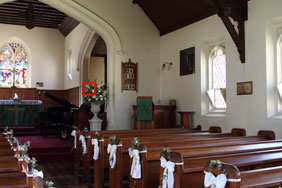 | To compare noise levels under real-life conditions we shot this scene with the Canon EOS 7D, EOS 50D and EOS 5D Mark II within a few moments of each other using their RAW modes and at each of their ISO settings. Scroll down for comparisons against the Nikon D300s and see the previous page for JPEG results. Each camera was fitted with the same Canon EF 24-105mm f4L IS lens, set to f8 in Aperture Priority mode and adjusted to deliver the same field of view. |
Noise Reduction was set to the default options on each camera, although we disabled any automatic contrast-enhancing modes as these can artificially introduce noise. As such, Auto Lighting Optimizer on all the Canon bodies was disabled. The image above was taken with the Canon EOS 7D at 100 ISO with an exposure of 1.3 seconds and with the lens set to 24mm f8; the original RAW file measured 22.5MB. The crops below are taken from the area marked with a red square and presented here at 100%.
The RAW files were processed using Canon’s Digital Photo Professional software, with the settings adjusted to match the sharpness for a level playing field. Despite their visible differences in JPEG sharpening by default, we found the EOS 50D and EOS 7D actually shared a similar degree of sharpness in their RAW files, with the same settings in DPP delivering similar output. The EOS 5D Mark II’s RAW files were inherently much sharper though, so we started with DPP’s default setting of 3 for each camera and adjusted them to meet somewhere in-between.
As such we increased DPP’s sharpening to five for both the EOS 50D and EOS 7D, and reduced it down to two for the EOS 5D Mark II. These settings delivered a similar degree of sharpness for the crops below. We also enabled DPP’s lens aberration correction, to reduce coloured fringing.
Compared with the previous page of JPEG results using the in-camera defaults, the boost in sharpening has made the world of difference to the EOS 50D crops, which now reveal finer details. Interestingly despite applying relatively modest sharpening to the EOS 5D Mark II’s RAW file (in order to match those from the EOS 50D and EOS 7D), its results also look crisper overall than those taken from its JPEG image; clearly even though it enjoys the best-looking JPEG output of the Canon bodies, the EOS 5D Mark II can enjoy even more quality by shooting in RAW. Of the three cameras, the EOS 7D interestingly reveals the least difference between JPEG and RAW here, although the boost in sharpening has made the noise artefacts more obvious both on it and the EOS 50D here.
As before, all three cameras deliver good-looking clean results at their lowest sensitivities, although some background noise textures are already becoming apparent on the EOS 50D and EOS 7D from 200 ISO. Compared side by side with the same degree of sharpening, these noise textures are more apparent on the EOS 7D than the EOS 50D, and by 400 to 800 ISO, they may begin to bother pixel-peepers. In the meantime, the EOS 5D Mark II is keeping things much cleaner, although despite all three cameras having fairly matched sharpening at the start of the sequence, it’s looking comparatively soft from 800 ISO upwards; we’d set DPP’s sharpening back to the default setting of three here.
The story remains the same at 1600 ISO, where the extra sharpening applied to both cropped bodies is making their noise quite apparent, although again more so on the EOS 7D. To be fair to the EOS 7D, these noise levels become similar at 3200 ISO, and avoid the chroma artefacts of the EOS 50D at 6400 and 12800 ISO – but equally the output is sufficiently compromised at these upper sensitivities for most people to avoid them where possible.
The EOS 5D Mark II also isn’t immune to noise and processing artefacts at higher sensitivities, although it retains a lead over the cropped bodies despite the softening seen here at the chosen settings.
Scroll down to see how the RAW output from the cropped Canon bodies compares against that from the Nikon D300s, or if you’re ready for more real-life images with the 7D, head straight over to our Canon EOS 7D Sample Images Gallery.
Canon EOS 50D RAW with Canon EF 24-105mm IS DPP with 5 sharpening |
Canon EOS 7D RAW with Canon EF 24-105mm IS DPP with 5 sharpening |
Canon EOS 5D Mark II RAW with Canon EF 24-105mm IS DPP with 2 sharpening | ||
 |
 |
 | ||
50 ISO not available |
50 ISO not available |
L (50 ISO) | ||
 |
 |
 | ||
100 ISO |
100 ISO |
100 ISO | ||
 |
 |
 | ||
200 ISO |
200 ISO |
200 ISO | ||
 |
 |
 | ||
400 ISO |
400 ISO |
400 ISO | ||
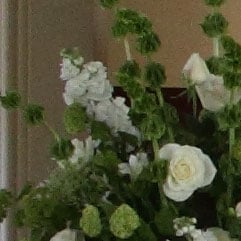 |
 |
 | ||
800 ISO |
800 ISO |
800 ISO | ||
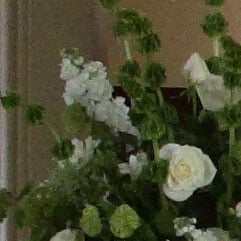 |
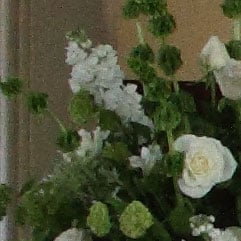 |
 | ||
1600 ISO |
1600 ISO |
1600 ISO | ||
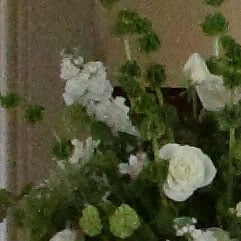 |
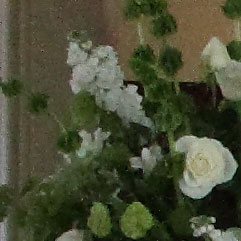 |
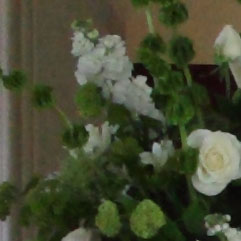 | ||
3200 ISO |
3200 ISO |
3200 ISO | ||
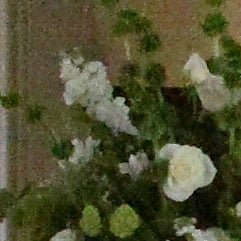 |
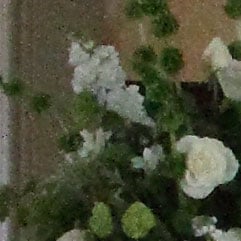 |
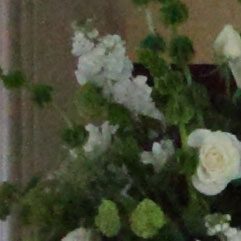 | ||
H1 (6400 ISO) |
6400 ISO |
6400 ISO | ||
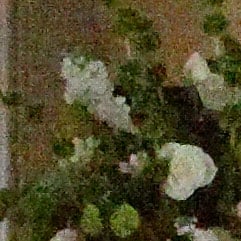 |
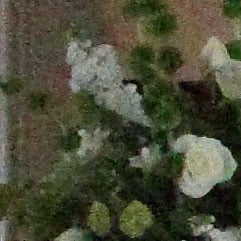 |
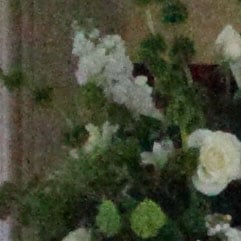 | ||
H2 (12800 ISO) |
H (12800 ISO) |
H1 (12800 ISO) | ||
 |
 |
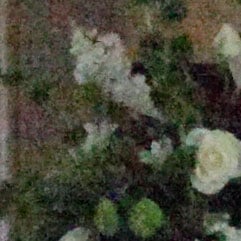 | ||
25600 ISO not available |
25600 ISO not available |
H2 (25600 ISO) |





